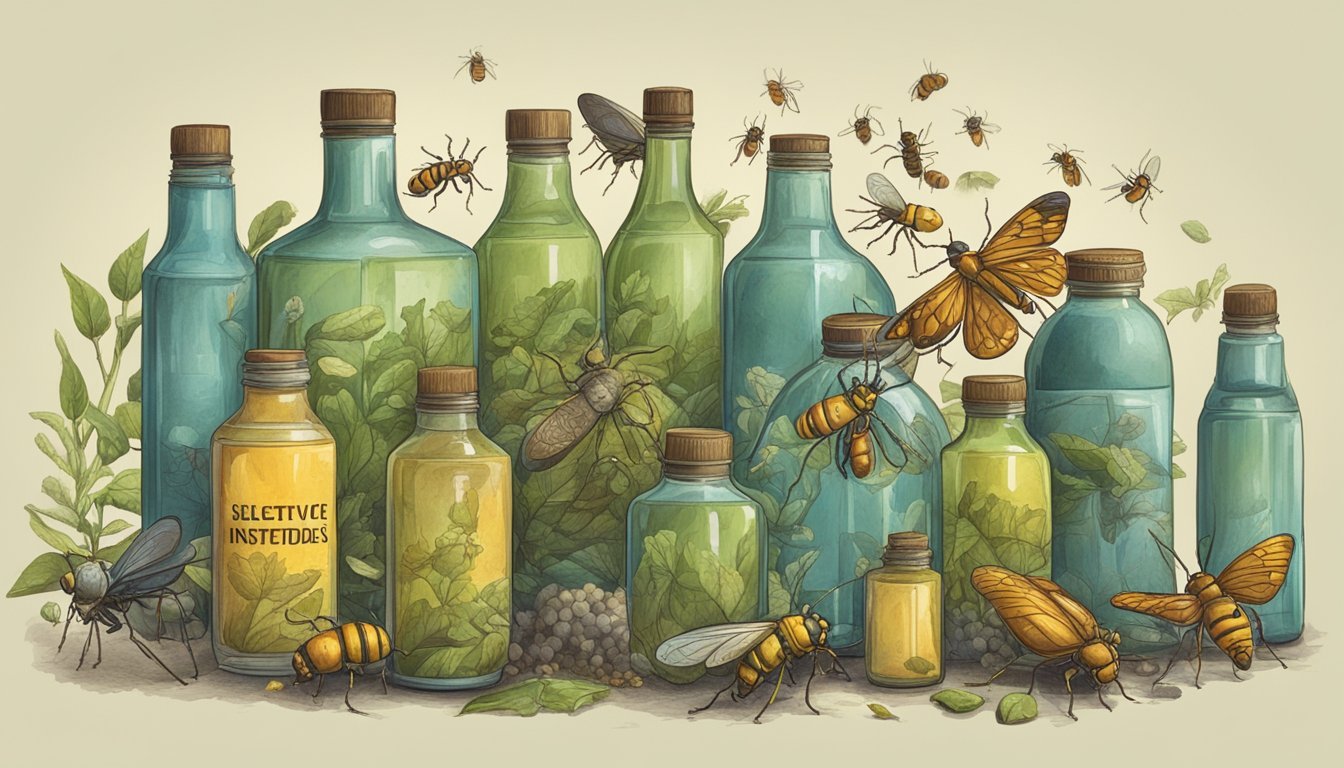Selective Insecticides
Advantages and Targeted Pest Control Methods
Selective insecticides are an integral component of sustainable agricultural practices. They are designed to target specific pests that threaten crops, while minimizing harm to beneficial organisms, such as natural enemies of pests, pollinators, and other nontarget species. Unlike broad-spectrum pesticides which can disrupt ecological balance, selective insecticides aid in preserving the health of the environment by reducing the overall chemical load introduced to ecosystems and preventing the eradication of beneficial species that contribute to natural pest control.
The efficacy of selective insecticides lies in their focused mode of action, which allows for effective pest management without the collateral damage associated with non-selective agents. The inherent selectivity reduces the risk of developing pest resistance and helps maintain the underlying biodiversity necessary for resilient agricultural systems. By implementing these targeted solutions, farmers are able to protect crops from damaging insects and mites, while still upholding ecological integrity and ensuring the continued participation of beneficials in pest control.
Understanding Selective Insecticides
Selective insecticides are designed to target specific pest species while minimizing harm to beneficial non-target organisms. This section explores their definition, types, and compares them with broad-spectrum insecticides.
Definition and Mechanism
Selective insecticides function by exploiting the biological differences between pest species and other organisms. These products typically affect only a narrow range of insect life stages or behaviors. For example, they may interfere with specific hormones crucial for an insect's development which are not present in non-target species, thereby allowing these non-target species to remain unharmed.
Types of Selective Insecticides
Insect Growth Regulators (IGRs): Mimic or inhibit hormones to disrupt insect development.
Biorational Insecticides: Often derived from natural sources, these target specific metabolic pathways.
Botanical Insecticides: Utilize plant-derived compounds that are toxic to certain pests.
Selective vs Broad-Spectrum Insecticides
Selective Insecticides Broad-Spectrum Insecticides Target Specific pest species A wide range of insects Impact Minimal on non-target organisms Potentially harmful to many insects, including beneficials Suitability Ideal for Integrated Pest Management (IPM) Used in scenarios with severe infestations
Selective insecticides are integral to pest management strategies that aim to preserve ecosystem balance. In contrast, broad-spectrum insecticides eliminate various insects indiscriminately and can upset ecological harmony.
Chemical Families of Selective Insecticides
Selective insecticides fall into several chemical families, each with unique properties and specific uses in pest control. Understanding these families helps in choosing the right pesticide to target pests while minimizing the impact on beneficial species.
Carbamates and Neonicotinoids
Carbamates, such as aldicarb, function by inhibiting an important enzyme in the nervous system of insects. They are versatile and fast-acting but have a moderate impact on non-target organisms. On the other hand, neonicotinoids, including imidacloprid, act on the nicotinic acetylcholine receptor, causing paralysis and death in insects. They are systemically taken up by plants, making them effective against sucking pests, and are less toxic to non-target species.
Pyrethroids and Spinosyns
Pyrethroids are synthetic analogs of the natural pesticide pyrethrin, derived from chrysanthemum flowers. They affect the nervous system of insects and have been engineered to be more stable in the environment. However, some beneficial insects, like bees, are also susceptible. Spinosyns, such as spinosad, are derived from the bacterium Bacillus thuringiensis. They disrupt the nervous system specifically in insect pests, showing reduced toxicity to non-target organisms and less risk of pesticide residues.
Insect Growth Regulators
Insect growth regulators (IGRs) mimic hormones in insects or interfere with the insect’s growth and development. They are instrumental in controlling pest populations, as they prevent insects from reaching maturity, thus halting reproduction. Their targeted mode of action means less harm to non-target species and reduces the overall use of broad-spectrum organophosphates that can be harmful to a wider range of organisms.
Benefits and Challenges
Selective insecticides play a crucial role in integrated pest management programs. They are designed to target specific pests while minimizing damage to beneficial organisms and the environment. Below is an assessment of their advantages and challenges.
Protection of Non-Target Species and Beneficials
Selective insecticides help preserve beneficial insects, which are natural enemies of pests, thereby sustaining a balanced ecosystem. By specifically targeting pest species, these chemicals reduce unintended impacts on nontarget species that contribute to pest control, like pollinators. This careful targeting is a result of precise risk assessment procedures that identify and minimize the effects on non-target organisms.
Environmental Impact and Persistence
The environment benefits from the use of selective insecticides through reduced chances of ecotoxicology issues compared to broad-spectrum pesticides. These products typically have lower persistence in the environment, decreasing the potential long-term impact on different ecosystems. However, any pesticide's environmental fate is complex and also depends on factors like the chemical properties of the substance and local environmental conditions.
Risk Assessment and Pesticide Residues
The development of selective insecticides involves thorough risk assessments to ensure safety and efficacy. They are subject to stringent residue analysis to ensure that levels in or on crops are within established safety thresholds. Despite this, the potential buildup of pesticide residues can still be a challenge, demanding continuous monitoring and evaluation to adhere to food safety standards and protect the health of consumers and the overall environment.
Application and Usage
Selective insecticides play a crucial role in the contemporary pest management paradigm, offering means to target pest species while reducing harm to beneficial organisms, thus aligning with integrated pest management (IPM) principles.
Agricultural Practices
In agricultural settings, selective insecticides are utilized to maintain crop health and production levels. Careful timing and precise application methods are essential to ensure effectiveness against target pest species, such as using spot treatments during times when pests are most vulnerable and natural predators are less active. These practices are often underpinned by extensive research to understand the life cycle of the target pest to inform the best application strategy.
Integrated Pest Management
Integrated pest management strategies often prioritize chemical and biological control methods that are less harmful to non-target species. The selection of insecticides that have low toxicity to natural enemies of pests is a cornerstone of IPM. It ensures that chemical interventions work synergistically with biological controls, such as the release of predatory insects or the use of pheromones to disrupt pest mating patterns.
Foliar Applications and Seed Treatments
Selective insecticides are often delivered via foliar applications, targeting pests that attack the aerial parts of the plant. They can be applied directly to the foliage where the pests reside, ensuring immediate and concentrated exposure. On the other hand, seed treatments involve coating seeds with insecticides to protect young plants from pest damage from the outset, promoting strong growth and development while minimizing soil residue. Seed treatments can play an integral role in cultural control by setting up the crop for reduced pest pressure throughout its life cycle.
Impact on Target Pests and Agricultural Ecosystems
Selective insecticides are designed to target specific pests while minimizing harm to beneficial organisms and the broader agricultural ecosystem. Their use can be a balancing act between controlling pests like aphids and thrips and preserving natural allies like lacewings and lady beetles.
Efficacy Against Specific Pests
Selective insecticides are highly effective against certain pests such as aphids and thrips, which can cause significant damage to a range of crops. For example, soybean crops heavily infested by aphids may experience yield reductions if not properly managed. These insecticides work by disrupting the nervous systems of targeted pests, often through the inhibition of specific enzymes essential to their survival.
Conservation Biocontrol
Conservation biological control is a key strategy in integrated pest management (IPM) that involves the use of selective insecticides to protect beneficial insects, such as parasitic wasps, predatory mites, and pollinators. Such practices help maintain the population of natural predators and parasitoids, as well as pathogens that contribute to pest control. The use of selective insecticides must therefore be strategic to avoid disrupting these beneficial organisms which play a crucial role in the sustainment of the agricultural ecosystem.
Crop-Specific Considerations
Each crop ecosystem has its unique set of challenges when it comes to pest control. Selective insecticides are used in a tailored manner to address these specific needs. For instance, botanical insecticides derived from plants can be effective for certain crops and pests, but their selectivity must be aligned with preserving the crop’s natural allies. Biological control agents themselves, like lady beetles for aphid management, can be adversely affected by non-selective insecticidal treatments, underscoring the importance of choosing the right type of control for each crop and pest scenario.
Regulations and Consumer Safety
The effective management of pesticides is vital for ensuring both environmental protection and consumer safety. This section explores the stringent regulatory frameworks that govern pesticide use and how they safeguard food quality and consumer health.
Pesticide Regulations and Limitations
Regulatory bodies strictly monitor the use of pesticides to minimize risks for both consumers and the environment. The US EPA is responsible for assessing and approving pesticides for use, ensuring they are safe when used according to label directions. Pesticides must pass rigorous evaluations to determine their "hazard quotient" – an estimate that ensures the chemical's exposure level is not harmful to humans. Regulatory compliance is not static; it continues through periodic reviews, refining the safe use of pesticides and addressing any emerging concerns.
Food Safety and Consumer Protection
The intersection of food production and pesticide use is governed by legal limits set for pesticide residues, known as tolerances. These tolerances are established by agencies like the EPA and enforced by the U.S. Food and Drug Administration (FDA). They ensure that the food reaching consumers is safe for consumption. Consumer protection is not solely about controlling pesticide levels; it's also about educating the public on safe pesticide practices and potential risks. The EPA provides resources on pest control and pesticide safety that guide consumers in making informed decisions to protect their families and the environment.
Emerging Developments
The landscape of insecticide development is rapidly evolving with significant advancements in both the discovery of novel active ingredients and the enhancement of application technologies. These developments aim to address the need for higher efficacy, lower environmental impact, and resistance management.
Novel Active Ingredients
Researchers are focusing on identifying new chemical classes that target specific aspects of insect biology to reduce environmental impact and non-target species toxicity. Spirotetramat and chlorantraniliprole, as part of the diamides class, are gaining attention due to their selectivity and lower risk to beneficial organisms. Indoxacarb, which is bioactivated inside the insect, provides another route for selective control. Meanwhile, naturally derived products like azadirachtin from neem (marketed as Neemix) continue to be explored for their insecticidal properties. Another example, pyriproxyfen, mimics natural insect hormones to disrupt growth and development, offering a highly targeted approach.
In the realm of bioinsecticides, abamectin, a fermentation product of Streptomyces avermitilis, represents the avermectins group, noted for their effectiveness as insecticides and miticides. Similarly, nuclear polyhedrosis viruses (NPV) specifically target certain insect pests, leading to a natural form of pest control that is non-toxic to humans and wildlife.
Advances in Application Technology
Application technology has also seen innovations aimed at precision and reduction of waste.
Ultra-low Volume (ULV) Spraying: ULV spraying systems use minimal amounts of concentrated formulas, providing efficient delivery of active ingredients like bifenthrin and chlorpyrifos, which have broad-spectrum activity.
Controlled-release formulations: These involve encapsulating active agents such as acetamiprid, allowing for the gradual release over time, enhancing lasting effects and reducing the frequency of applications.
Drone Technology: Drones are now being employed to distribute insecticides like buprofezin and dimethoate over crops with exceptional precision, reducing the amount of chemical used and minimizing operator exposure.
Targeted Gel Baits: This approach, often used with cockroach and ant populations, applies small quantities of insecticides such as cyfluthrin directly to the areas of infestation, limiting non-target exposure and promoting the conservation of beneficial species.
Across these innovations, there is a consensus on integrating organophosphorus and carbamate insecticides in application advancements to manage resistance, ensuring their sustained effectiveness in the field. Furthermore, the development of application techniques that synergize with herbicides further streamlines agricultural pest management operations.
Frequently Asked Questions
Selective insecticides offer targeted pest control which preserves beneficial species and minimizes ecological disruption. This section addresses common inquiries regarding their use and effects in agriculture.
What are the benefits of using selective insecticides over broad-spectrum insecticides?
Selective insecticides are designed to target specific pests, reducing the impact on non-target organisms and helping to preserve beneficial insects like pollinators and natural predators. They play a critical role in integrated pest management by allowing natural pest control mechanisms to remain intact.
Can you list three examples of selective insecticides commonly used in agriculture?
Common examples of selective insecticides include pyriproxyfen and buprofezin, which are noteworthy for their safety profile towards beneficial insects like lacewings. Spinosad is another example noted for its effectiveness against caterpillars while being less harmful to many beneficial insects.
How do selective insecticides differ in their mode of action compared to non-selective types?
Selective insecticides often target specific physiological processes within the pest species, such as disrupting insect growth or inhibiting specific enzymes crucial to the pest. Non-selective insecticides, on the contrary, generally have a broader mode of action that can affect a wider range of species, including beneficial organisms.
What impact do selective insecticides have on non-target organisms in the environment?
Selective insecticides are designed to minimize their impact on non-target organisms, including natural predators and pollinators. However, some selectivity depends on the precise application, including the timing, dosage, and delivery method to avoid unintended consequences for other organisms in the eco-system.
How does the persistence of selective insecticides in the environment compare to broad-spectrum pesticides?
Selective insecticides often break down more quickly in the environment than broad-spectrum pesticides, reducing the risk of long-term residue and cumulative ecological effects. However, persistence can vary based on chemical structure, environmental conditions, and specific formulations.
In what situations are selective insecticides preferred over narrow spectrum pesticides?
Selective insecticides are especially favored in situations where pest populations are localized and specific, where beneficial insects are crucial for pollination and as natural pest controls, and within integrated pest management systems where chemical controls are used as a last resort.







